
The Lygaeidae are a family in the Hemiptera, with more than 110 genera in four subfamilies. The family is commonly referred to as seed bugs, and less commonly, milkweed bugs, or ground bugs. However, while many of the species feed on seeds, some feed on sap (mucivory) or seed pods, others are omnivores and a few, such as the wekiu bug, are carnivores that feed exclusively on insects. Insects in this family are distributed across the world. The family was vastly larger, but numerous former subfamilies have been removed and given independent family status, including the Artheneidae, Blissidae, Cryptorhamphidae, Cymidae, Geocoridae, Heterogastridae, Ninidae, Oxycarenidae and Rhyparochromidae, which together constituted well over half of the former family.

Nysius is a genus of false chinch bugs in the family Lygaeidae. At least 100 described species are placed in Nysius.

Tenebrio is a genus of darkling beetles. Adults are 12–18 mm (0.47–0.71 in) long and can live for 1–2 years. The larvae are minor pests, but they are also widely reared and sold as pet food.
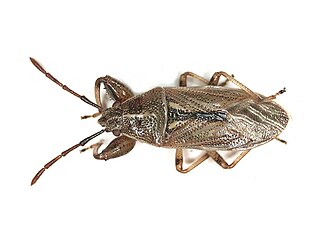
Oedancala dorsalis is an insect, found in the superfamily Lygaeoidea which is one of the largest varied family of Heteroptera of Hemiptera. Seed bugs are a very diverse family of seed feeders found on various types of vegetation. There are four Nearctic species in this genus. O. bimaculate and O. cubana are neotropical species that barely make it into the United States.
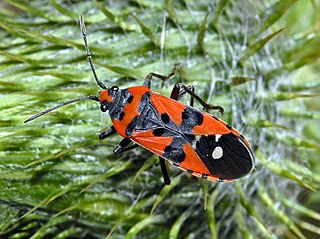
Lygaeus is a genus of seed bugs in the family Lygaeidae. There are more than 60 described species in Lygaeus.

Arocatus melanocephalus, the elm seed bug, is a true bug in the family Lygaeidae. The species was initially described by Johan Christian Fabricius in 1798, and Maximilian Spinola designated it to be the type species of the genus Arocatus in 1837. This bug is native to Europe but has been introduced to North America.

Neacoryphus is a genus of seed bugs in the family Lygaeidae. There are about five described species in Neacoryphus.
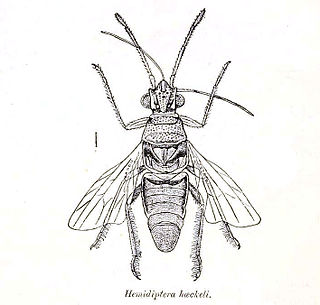
Orsillinae is a subfamily of seed bugs in the family Lygaeidae. There are at least 110 described species in Orsillinae; the type genus is Orsillus.

Drymini is a tribe of dirt-colored seed bugs in the family Rhyparochromidae. There are more than 300 described species in Drymini.

Ochrimnus is a genus of seed bugs in the family Lygaeidae. There are more than 40 described species in Ochrimnus.
Lygaeospilus is a genus of seed bugs in the family Lygaeidae. There are at least four described species in Lygaeospilus.

Melanopleurus is a genus of seed bugs in the family Lygaeidae. There are more than 20 described species in the genus Melanopleurus.
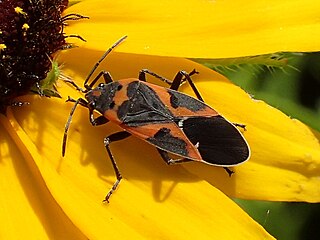
Lygaeus kalmii, known as the small milkweed bug or common milkweed bug, is a species of seed bug in the family Lygaeidae. It is found in Central and North America.
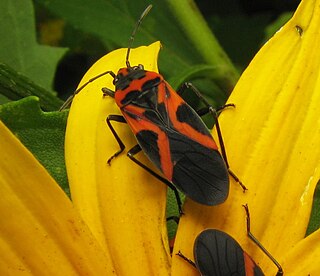
Lygaeus turcicus, the false milkweed bug, is a species of seed bug in the family Lygaeidae. It is found in Eastern North America.

Ischnorhynchinae is a subfamily of seed bugs in the family Lygaeidae. There are about 16 genera and more than 70 described species in Ischnorhynchinae. The members of this subfamily are small, terrestrial insects that typically translucent or transparent plate-like structures covering the thorax (pronota) and tend to live in plant flowers.

Crompus is a genus of seed bugs in the family Lygaeidae. Crompus are terrestrial insects in the Ischnorhynchinae subfamily of seed bugs that are endemic to Australia. There are three described species in Crompus.
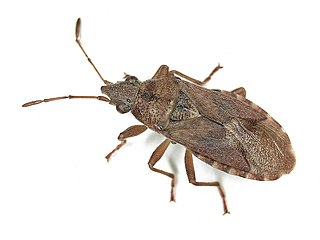
Orsillus depressus is a species of seed bug in the family Lygaeidae. It is a terrestrial insect native to southern Europe. It is considered a naturalized introduced species in the UK. O. depressus was first recorded in England in the 1980s and is now common throughout central and southern England. In southern Europe, its host plants are trees in Cupressaceae while in the UK Lawson's cypress is the most common host plant. O. depressus is approximately 6 mm in length and has a browny-orange coloration. Like many other species in Lygaeidae, O. depressus is a phytophagous species, feeding on plants, and it is commonly found in woodland/forest habitats and in cultivated areas of gardens and parks.
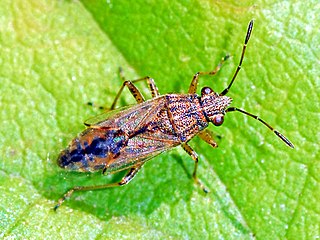
Nysius graminicola is a species of seed bug in the subfamily Orsillinae and in the family Lygaeidae.
Baeoentedon bouceki is a species of wasp, one of the first three members of the genus Baeoentedon to be discovered in China. It is less than a millimetre in length, with a head slightly wider than the middle portion of the body. Only one specimen has been studied, collected from Hainan in 1983. As that specimen is female, the appearance of males is unknown.

















